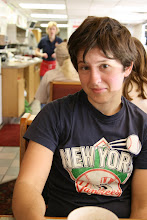 I spoke to my parents the other day to get ready for a new drawing that I've been thinking about for over a year. My mother sent me a copy of their wedding invitation the summer before last and I thought then (and still do) that it was so lovely-- the insects and flower are my father and mothers graduate dissertation topics respectively. The story goes that after my parents were hitched they went to Latin America to help eachother with field research. They took my fathers collapsible kayak and paddled down a river until the water shallowed so much that the river bed scratched holes in the bottom of the craft and my parents were submarined. They pulled the kayak and all their things to the side of the river and my father hiked barefoot through a field of poison ivy. A sidestory here: when he was a kid, my father had not been allergic to poison ivy, and had been the brunt of many Indiana summer-camp dares to rub it all over his face. Decades later and he had his first allergic reaction, unfortunately, all over his legs, on the bottoms of his feet, and between his toes. Usually when this story is getting told my father emphasizes how horrible and itchy he was, but underscores how he had helped save the day (David Baldwin, family martyr). My mother usually likes to talk about how incredibly unsexy it was, them being on their honeymoon and him being rashy from the mid-thigh down.
I spoke to my parents the other day to get ready for a new drawing that I've been thinking about for over a year. My mother sent me a copy of their wedding invitation the summer before last and I thought then (and still do) that it was so lovely-- the insects and flower are my father and mothers graduate dissertation topics respectively. The story goes that after my parents were hitched they went to Latin America to help eachother with field research. They took my fathers collapsible kayak and paddled down a river until the water shallowed so much that the river bed scratched holes in the bottom of the craft and my parents were submarined. They pulled the kayak and all their things to the side of the river and my father hiked barefoot through a field of poison ivy. A sidestory here: when he was a kid, my father had not been allergic to poison ivy, and had been the brunt of many Indiana summer-camp dares to rub it all over his face. Decades later and he had his first allergic reaction, unfortunately, all over his legs, on the bottoms of his feet, and between his toes. Usually when this story is getting told my father emphasizes how horrible and itchy he was, but underscores how he had helped save the day (David Baldwin, family martyr). My mother usually likes to talk about how incredibly unsexy it was, them being on their honeymoon and him being rashy from the mid-thigh down.I asked my parents for the scientific names of the things they studied since I was having a hard time getting images on my own. There is, as it turns out, an incredible variety of milkweed bugs-- but my father studied Oncopeltus fasciatus solely. For years I've been telling my friends that my mom studied a flower called Silene ecbalium, but on the phone she corrected me, as no such plant exists. Her dissertation was about a plant called Ecbalium elaterium, and then she studied a plant called Silene latifolium when we lived in New Jersey. I had morphed the two (incredibly dissimilar) plants together, which sounds like good premise for a drawing-- what would Silene ecbalium even look like?

No comments:
Post a Comment